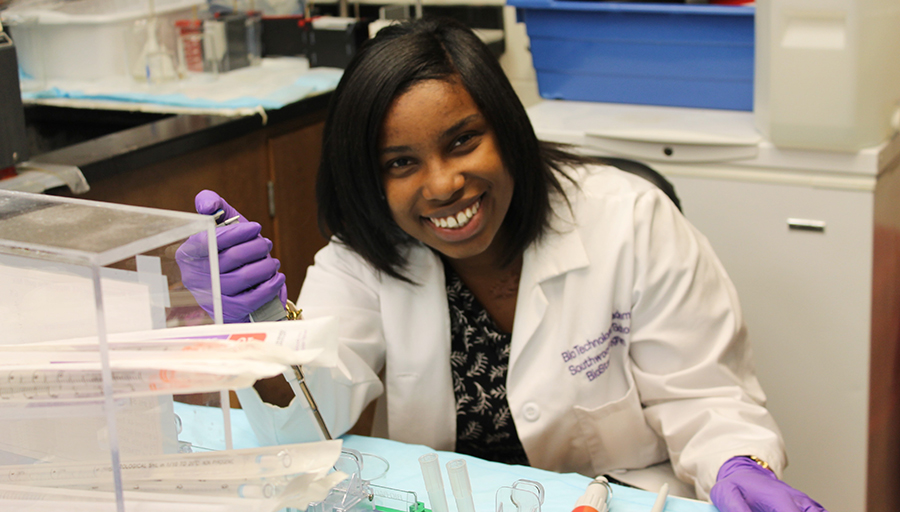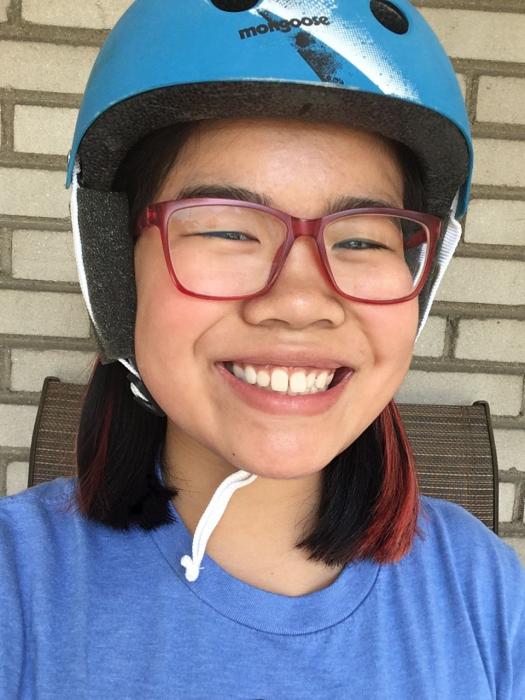Teen scientists invent accessible devices, research cancer

A high school student inspired by her own hearing loss and use of hearing aids created an effective wind noise reduction device. Another is researching head and neck cancer — specifically how to inhibit cancer growth.
Nurturing the next generation of scientists — like these young women — is one of our main goals at the Society for Science & the Public. To help us reach this goal, the Society recognized 20 students competing in science fairs throughout the country to recognize their STEM efforts. These Community Innovation Awards, part of the Society’s STEM Action Grants, recognize amazing young scientists.
We spoke with two award winners below to find out how they first became interested in science, and what they hope to do next.

TINA PAKKO, DETROIT
WHAT THE COMMUNITY INNOVATION AWARD MEANS TO HER: This award means a lot to me. I’m ecstatic to discover that my wind-reduction device can help other people in the community, and not just myself. My career goal is to design products that help people. This was such a valuable experience and a big step towards my future goals.
My career goal is to design products that help people.
HOW HER WIND REDUCTION DEVICE WORKS: My device works by reducing the turbulence that causes wind noise. Turbulence occurs when air flows around obstructions; in this case, around the helmet straps and the outer ear (pinna). Behind-the-ear hearing aids are located in this area of high turbulence.
It’s important that my device works by reducing turbulence and not by muffling all sounds. Other sounds such as cars and emergency sirens can still be heard. People who do not wear hearing aids may also benefit, since there is still turbulence around the helmet straps. However, when I placed the microphone inside the ear canal of my model head, not as much wind noise was recorded. That may show that wind noise is not as big of a problem for people without hearing aids (this data was not included in my report).
My device works by reducing the turbulence that causes wind noise … Behind-the-ear hearing aids are located in this area of high turbulence.
My device uses speaker foam attached to a bike helmet strap using velcro strips on both sides of the head. The foam fills the gap between the strap and the head. I found that the foam with the highest porosity and largest pore size worked best. I believe this is because the high-porosity foam allowed air to flow through it, smoothing the airflow, and thus reducing turbulence. Lower-porosity foam just forced the flow around the device and didn’t work as well.
I found that the device worked only when the air is flowing directly into the person’s face. This condition is present while biking and perhaps skateboarding and skiing. If the airflow came from the side, it didn’t work.
HOW SHE BECAME INTERESTED IN ACCESSIBILITY/ACCESSIBLE DEVICES: I personally use hearing aids to correct mild hearing loss and experience wind noise while biking. I have also noticed that other people with hearing loss struggle with this issue. While doing research for this project, I discovered wind noise can have detrimental effects over time. The products already on the market do not fit the needs of a hearing-impaired individual who uses hearing aids.
I am interested in both science and industrial design, and accessibility is an area in which both are needed. In the case of my project, a scientific understanding of turbulent flow, sound, and statistics were all needed to be technically successful. But to also be successful in the marketplace, a device like mine needs to be both aesthetically pleasing and convenient for people to use. I’m excited about using technology to help people, but as a hearing aid user myself, I’m aware of the challenges of successfully meeting those needs.
Support other amazing young scientists by becoming a member!
HER CURRENT STEM GOALS: As a sophomore in high school, I am exploring a diverse range of career options. I have become focused on industrial design, where designers solve problems using technology and innovation. These problems can be related to STEM fields such as 3D-printed prosthetics or the creation of products that increase accessibility for those who are disabled.
I’m focused on industrial design, where designers solve problems using technology and innovation.
HOW SHE FIRST BECAME INTERESTED IN STEM: In fifth grade, I learned about the science of microbiology. It fascinated me to discover that millions of microscopic worlds exist within a large and complicated visible world.
ON THE IMPORTANCE OF SCIENCE FAIRS: Science fairs and competitions are important because they allow students of all ages to propose solutions in new and creative ways, as well as showcase their individual talents. Along with this, students can become inspired by other people’s projects and explore many STEM fields.
Science fairs and competitions allow students of all ages to propose solutions in new and creative ways.
HER ADVICE TO OTHERS INTERESTED IN STEM: I believe that anyone can do worksheets and rote memorization; however, it takes creativity to develop something truly unique and make your own personal mark in the STEM world. Expose yourself to a wide variety of experiences and academic disciplines that could inspire you.

KEARRA ODUMS, LOUISIANA
WHAT THE COMMUNITY INNOVATION AWARD MEANS TO HER: This award was an honor because this means my project could possibly impact my community and make a difference.
I would like to thank Ms. Cathy Williamson for everything you have done; Tye Martinez for always trying to make us see the positive, even when there was no positive side; and a special thanks to Dr. Zhao for lending me his lab and fellows, Anu and Hondu.
HOW SHE BECAME INTERESTED IN STUDYING CANCER: My research involves a lot of knowledge and interest with the study of head and neck cancer. I became involved with this topic because cancer plays an important role in my family history and I have lost relatives because of it. I made up in my mind that it may not be breast, lung, or pancreatic cancer but it’s some form of cancer I can start with. My number one goal is to get as close to a cure for cancer as soon as possible.
Since the UCP2 gene is highly expressed in cancer, inhibition of it can suppress cancer growth.
My hypothesis is that since the UCP2 gene is highly expressed in cancer, inhibition of it can suppress cancer growth. My figure on anchorage independent growth proves that. In my project, the M-Tor study serves as a molecular mechanism to explain why UCP2 inhibition suppresses cancer growth, since M-Tor is known to contribute to cancer growth and the UCP2 makes it grow faster, which is bad.
ON THE IMPORTANCE OF SCIENCE FAIRS: Science competitions are important because they push you to actually study and know about your project, but it always gives other individuals the information so they can use it throughout their lives. It gives the competitor knowledge about other scientific projects.
HOW SHE FIRST BECAME INTERESTED IN STEM: It started with my last year of junior high when Southwood College came and told us about the biotechnology program. They told us it was a good start to the medical field and ever since I have been in this program.
Never stop reading up on the latest technologies and explore all fields in science.
HER ADVICE TO OTHERS INTERESTED IN STEM: Just say focused and never stop reading up on the latest technologies and explore all fields in the science area, because you never know which category you might enjoy.Read about more Community Innovation Award Winners


